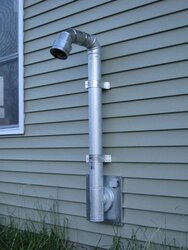Hello All
So i wanna clear up a question I have. I just purchased a Breckwell Big E Pellet stove. I am installing in my basement. I wanted to put it next to my furnace, ( meeting all clearance req) but I cant put it near the wall as it would be obstructed by the chimney and Furnace. My question is with the horizontal EVL. According to the brochure my max horizontal evl is 10 feet. I have a 90deg T with clean-out out of the stove to a 5' vertical, topped with a 90 deg, to a 7' horizontal. after that I need 2 90 deg elbows with a short 2' horizontal to exit the house. According to my "brochure that is 29' horizontal evl. ( 90 deg elbow = 5 evl x4 and 9' horizontal evl..)Is that right? I guess my problem is that if you use 2 90 elbows then you cant run 1 piece of horizontal.
My other option is to use 2 45 deg elbows (at 3 evl each) plus the 7 ' horizontal ( which now becomes pitched about 3' in the 7' run) and then the 2' exiting the house. but i still need a 90 to go up the side of the house.
I cant see only being able to use 2 90 deg elbows in an installation. and no horizontal pipe?
If I move the stove to the wall then the furnace is right in front of it and I don't see it circulating through the basement. I have no other location to exit the house due to proximity of windows, porches, propane tank, etc.
Thanks in advance.
So i wanna clear up a question I have. I just purchased a Breckwell Big E Pellet stove. I am installing in my basement. I wanted to put it next to my furnace, ( meeting all clearance req) but I cant put it near the wall as it would be obstructed by the chimney and Furnace. My question is with the horizontal EVL. According to the brochure my max horizontal evl is 10 feet. I have a 90deg T with clean-out out of the stove to a 5' vertical, topped with a 90 deg, to a 7' horizontal. after that I need 2 90 deg elbows with a short 2' horizontal to exit the house. According to my "brochure that is 29' horizontal evl. ( 90 deg elbow = 5 evl x4 and 9' horizontal evl..)Is that right? I guess my problem is that if you use 2 90 elbows then you cant run 1 piece of horizontal.
My other option is to use 2 45 deg elbows (at 3 evl each) plus the 7 ' horizontal ( which now becomes pitched about 3' in the 7' run) and then the 2' exiting the house. but i still need a 90 to go up the side of the house.
I cant see only being able to use 2 90 deg elbows in an installation. and no horizontal pipe?
If I move the stove to the wall then the furnace is right in front of it and I don't see it circulating through the basement. I have no other location to exit the house due to proximity of windows, porches, propane tank, etc.
Thanks in advance.




 i recieved some false info from the company i bought it from. so that is why i am a little unsure of all this.
i recieved some false info from the company i bought it from. so that is why i am a little unsure of all this. 